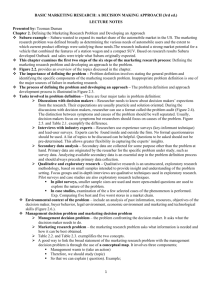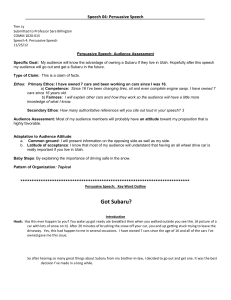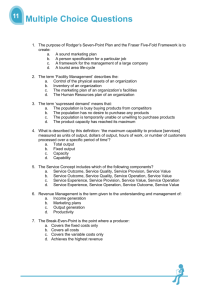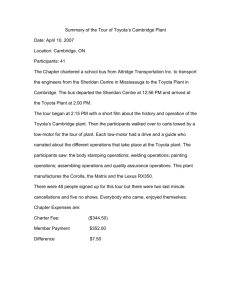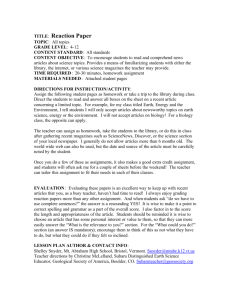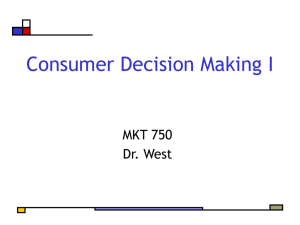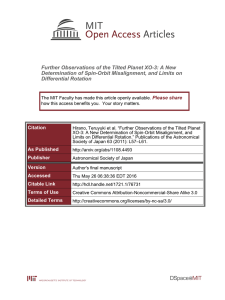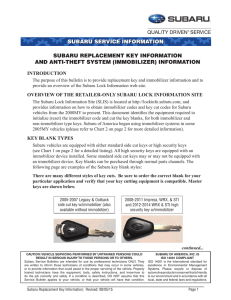To the Stakeholders of Fuji Heavy Industries Ltd.
advertisement
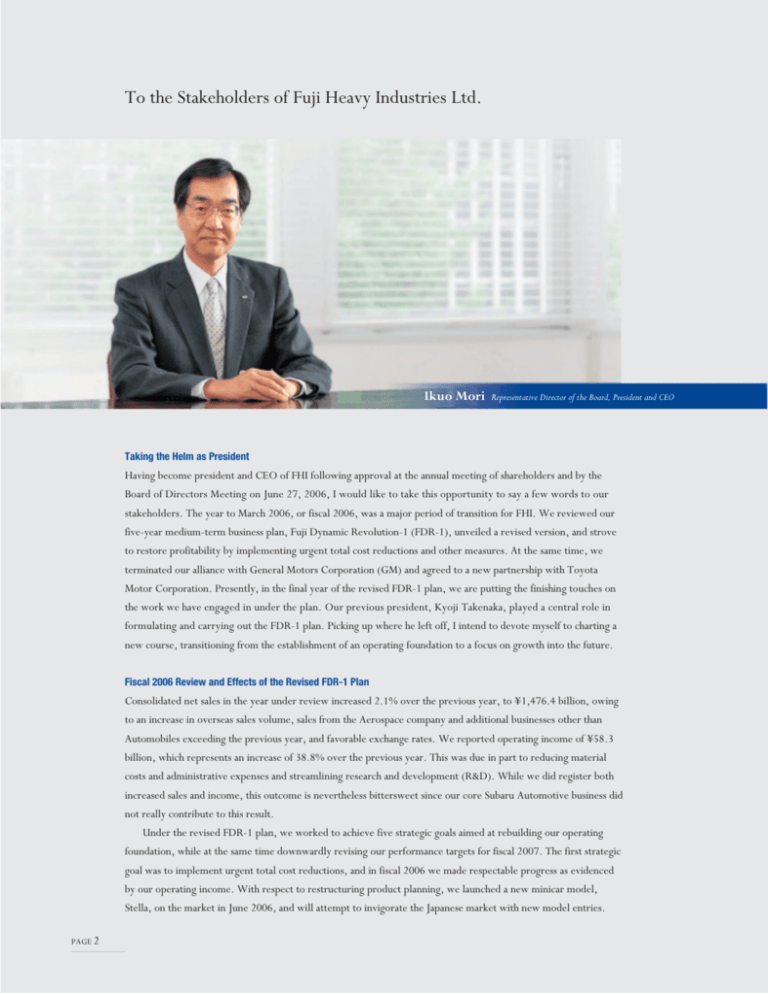
FUJI HEAVY INDUSTRIES LTD. ANNUAL REPORT 2006 To the Stakeholders of Fuji Heavy Industries Ltd. Ikuo Mori Representative Director of the Board, President and CEO Taking the Helm as President Having become president and CEO of FHI following approval at the annual meeting of shareholders and by the Board of Directors Meeting on June 27, 2006, I would like to take this opportunity to say a few words to our stakeholders. The year to March 2006, or fiscal 2006, was a major period of transition for FHI. We reviewed our five-year medium-term business plan, Fuji Dynamic Revolution-1 (FDR-1), unveiled a revised version, and strove to restore profitability by implementing urgent total cost reductions and other measures. At the same time, we terminated our alliance with General Motors Corporation (GM) and agreed to a new partnership with Toyota Motor Corporation. Presently, in the final year of the revised FDR-1 plan, we are putting the finishing touches on the work we have engaged in under the plan. Our previous president, Kyoji Takenaka, played a central role in formulating and carrying out the FDR-1 plan. Picking up where he left off, I intend to devote myself to charting a new course, transitioning from the establishment of an operating foundation to a focus on growth into the future. Fiscal 2006 Review and Effects of the Revised FDR-1 Plan Consolidated net sales in the year under review increased 2.1% over the previous year, to ¥1,476.4 billion, owing to an increase in overseas sales volume, sales from the Aerospace company and additional businesses other than Automobiles exceeding the previous year, and favorable exchange rates. We reported operating income of ¥58.3 billion, which represents an increase of 38.8% over the previous year. This was due in part to reducing material costs and administrative expenses and streamlining research and development (R&D). While we did register both increased sales and income, this outcome is nevertheless bittersweet since our core Subaru Automotive business did not really contribute to this result. Under the revised FDR-1 plan, we worked to achieve five strategic goals aimed at rebuilding our operating foundation, while at the same time downwardly revising our performance targets for fiscal 2007. The first strategic goal was to implement urgent total cost reductions, and in fiscal 2006 we made respectable progress as evidenced by our operating income. With respect to restructuring product planning, we launched a new minicar model, Stella, on the market in June 2006, and will attempt to invigorate the Japanese market with new model entries. PAGE 2 FUJI HEAVY INDUSTRIES LTD. ANNUAL REPORT 2006 And, starting in 2007, we plan to introduce Full Model Changed (FMC) vehicles (completely redesigned models) on an annual basis. For restructuring sales processes and networks, we did make steady progress in network development, but are only halfway there in terms of improving customer satisfaction. Finally, with respect to streamlining the corporate structure, we made substantial progress in shifting to structure supporting higher earnings in our three internal companies. Doing so, however, required us to make the agonizing decision of hastening the retirement of over 700 employees. On the whole, our efforts under the revised FDR-1 plan delivered a certain level of results. With our goals going forward clear, we intend to accelerate initiatives under the new regime to propel us to our next stage of growth. Issues and Initiatives Ahead of Our Next Medium-Term Business Plan I will first explain the major issues that Subaru is currently facing. The first involves our orientation to customers, which is a perpetual issue for Subaru. Over the past five years, the entire company engaged in work related to this issue, but looking back, I am forced to conclude that our efforts did not deliver adequate results. I have the sense that our FDR-1 plan did not fully change our corporate culture that for many has believed that if we make a good product it will certainly sell. For Subaru, making good products is not enough; we must be oriented more to our customers, and unfortunately, as of the present, we are still not where we should be. We must first raise customer satisfaction in every phase—product development, manufacturing, sales and services—which will consequently lead to sales of new cars. It is essential for us to build a customercentered value chain, so it is incumbent upon all of Subaru, including executives, to change its way of thinking. We started by identifying three issues. The first is to achieve the targets of the revised FDR-1 plan. The second is to clarify the substance of our alliance with Toyota and make it a success. And the third is to formulate a new medium-term business plan for our growth in the next fiscal year and beyond. Finishing Up the Final Year of the FDR-1 Plan Our most important agendas for the final year of the FDR-1 plan are to continue to strengthen our Total Cost Structure Revolution (TSR), work to improve the efficiency of R&D costs and administrative expenditures, and raise our overall cost competitiveness. On the sales side, we will further rationalize dealer management in Japan by merging some dealerships starting April 2006 and allocate the resulting resources to bolstering our sales force in order to improve sales productivity. In the U.S., we are working to strengthen our dealerships by launching the Site Control program involving direct investment in dealer facilities by Subaru of America, Inc. (SOA), our U.S. marketing & distributing subsidiary. Through these initiatives, we plan to reform our sales structure into a highquality operation directed at customer satisfaction. OVERVIEW OF FDR-1 (Billions of yen) 555,421 (units) 1,372.3 2003 67.5 553,013 (units) 1,439.5 2004 50.3 1,446.5 600,577 (units) 2005 42.0 1,476.4 589,237 (units) 2006 58.3 1,550.0 598,000 (units) 2007 50.0 (Forecast) Actual Unit Sales Net Sales Operating Income PAGE 3 FUJI HEAVY INDUSTRIES LTD. ANNUAL REPORT 2006 Alliance with Toyota Next, through our alliance with Toyota Motor Corporation, we intend to absorb Toyota’s sophisticated expertise, improve Subaru’s productivity and enhance our product strength by producing Toyota vehicles, and share technologies at Subaru of Indiana Automotive, Inc. (SIA), our U.S. production subsidiary. We hope to build a robust, longstanding relationship with Toyota by enhancing synergies in areas other than production and development as well, and continuing to deepen the trust between the two companies. Formulating Our Next Medium-Term Business Plan Along with steadily carrying out the aforementioned two major agendas to shore up the company’s management base, we will also formulate our next medium-term business plan for FHI going forward, a task that I personally consider a major undertaking. FHI urgently needs to develop a system for aggressively developing unique Subaru products that reflect the wishes of customers and for delivering high-quality, cost-competitive products to the market in a timely manner. Bolstering our overall sales capabilities both in Japan and overseas is also a pressing issue. So along with raising efficiency, we intend to create a plan for making necessary investment in dealer infrastructure and devote effort to personnel-related issues, including improving the quality of customer service. In doing so, we will seek to realize a high-quality brand of sales and service that engenders true customer satisfaction. Conclusion Along with engaging in the business activities outlined above, we will proactively carry out activities to fulfill our social responsibilities as a corporation, including environmental conservation and compliance-related initiatives, and will seek to be an attractive company with a strong market presence—a company that is trusted by shareholders, customers, and all other stakeholders. By focusing our efforts on brand development and marketing rooted in orientation to our customers, we will take our first steps toward a new stage of growth. I hope that you share in our expectations for the potential of Subaru going forward. Ikuo Mori Representative Director of the Board, President and CEO PAGE 4


